
Katie and Megan Pearson are a married couple living in Toronto. They have three kids: Duke, 4, Poppy, 3, and Dermott, 1. Megan carried Duke, and Katie carried the other two, although their third child was made with Megan’s egg.
They were happy to share their story, because they know how complicated it was to navigate the fertility process as a same-sex couple. “Finding information about where to get sperm isn’t super accessible. You really have to dig,” Megan said. “It’s kind of a weird secret society.”
Megan: There’s many, many decisions that come with every step. What kind of sperm? How much do you get? What do you care about in terms of a donor? I’m mixed-race, Black and white, and Katie is white. So we discussed race and what kind of sperm to get.
Katie: When Megan was pregnant with our first, we picked a Caucasian donor, because we were trying to best represent me. We went with an anonymous donor: I think legally and logistically, an unknown donor is a little bit simpler.
When you pick a donor, they have to come from the U.S. It’s illegal to buy and sell sperm in Canada. Our clinic was affiliated with three firms in the States who will ship it up to Canada. So you can import it, but you can’t purchase it here.
Megan: It’s just bizarre to have to jump through these hoops. You don’t think about it until you have to do it.
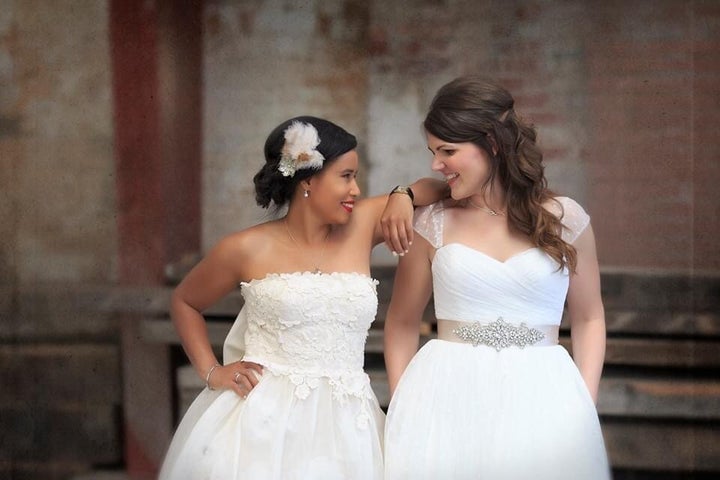
Megan: And we weren’t sure whether it was important to have the same donor at the time…
Katie: For us it was important to pick an open ID donor. That means that if you successfully get pregnant and register the birth with the sperm bank, when our children turn 18, they can request the contact information of their donor. We thought it was important that they have the option.
Katie: Megan was pregnant first, strictly because Megan is four years older than me. Our first, Duke, was IUI, intrauterine insemination. Every month we would list our top three sperm choices, and the clinic managed ordering it from the U.S. They would monitor Megan’s cycle and on the day she ovulated, they would put sperm in her uterus and let nature do its thing.
Megan: IUI is basically a turkey baster.
Katie: We got pregnant on the second try, which I understand is pretty lucky.
Megan: I don’t think the equity piece weighed on me. Growing up as a Black queer woman, there’s a lot of inequity. I’m no stranger to that.
What was weighing most for me was that it was all very invasive. At the clinic you have someone looking at your body constantly, and you’re constantly writing down your cycle. I think one of the challenges is that for medical professionals, it’s something that they do all the time. I think practitioners can often forget how little first-timers know.
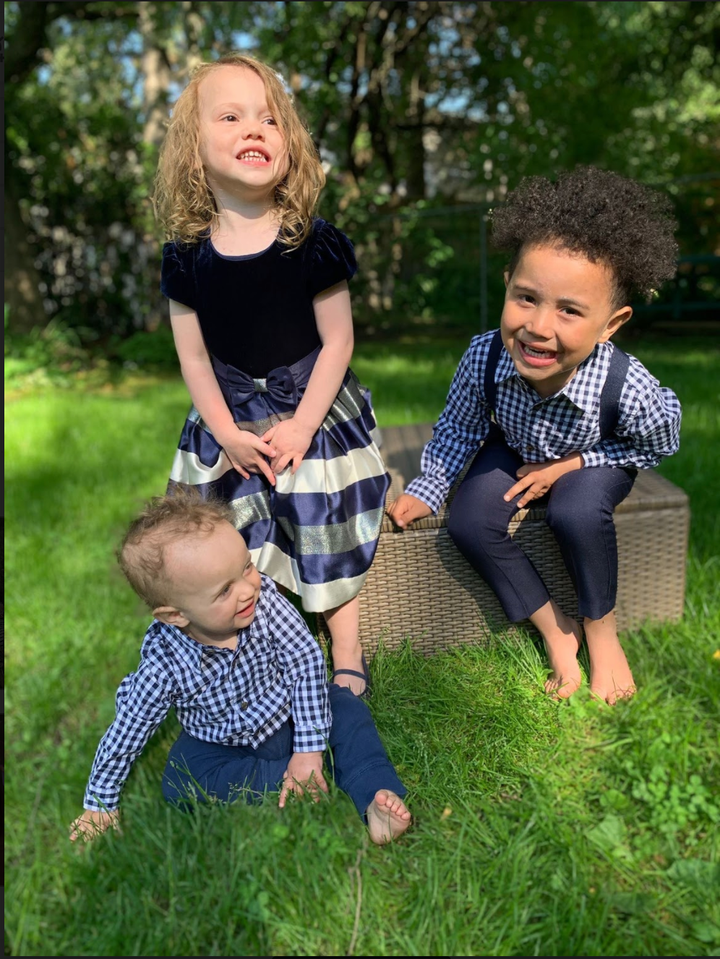
Katie: We needed to provide a medical reason for why we were at the clinic. I think I remember saying, ‘Lack of sperm?’ It seemed so obvious.
Megan: Looking back, we didn’t quite understand how much autonomy we could have had. Most fertility clinics are for straight couples who have trouble getting pregnant. For us, it was like, ‘You have to get this test done to see if your fallopian tubes are open.’ Well, did I actually have to do that test? A woman who has struggled to get pregnant needs to figure out why she can’t get pregnant, but we’re not here to figure out why we can’t get pregnant. We’re here because someone needs to help us get sperm into our bodies.
Katie: I think our initial thought was that when it was time for me to get pregnant with our second child, we would look for a Black donor to kind of represent Megan.
But we started thinking, what would our family look like if years from now we end up with three or four children who all have different donors? Is there a Christmas dinner table that includes four different men? We wanted to simplify, and we wanted there to be some sort of thread between the children.
“It’s a rich person’s endeavour for sure.”
- Megan
Katie: We went back to the fertility clinic and we bought the last four units of sperm that were available from Duke’s donor.
Megan: But that cost money.
Katie: That cost money. A unit of sperm is about $1000. And apparently you can get three to five units of sperm from one donation.
Katie: A unit is not one ejaculation! A man goes in and ejaculates into a cup and someone is making five grand. The finances of having children —
Megan: It’s a rich person’s endeavour for sure.
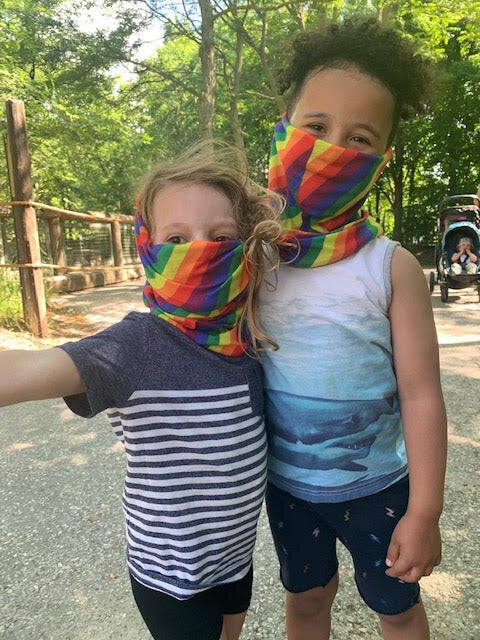
Katie: We were very, very lucky to have some pretty incredible benefits through work.
Megan: We’re lucky that we’re highly educated, resourced people who have the wherewithal to navigate this system. I think that if you don’t have those things, having a baby becomes a lot less joyful. And there’s less of a chance that you can even have one.
“I was listed on the birth certificate as father-slash-second-parent.”
- Katie
Katie: At the time Duke was born, Megan was listed as mother. And I was listed on the birth certificate as father-slash-second-parent. But I could be listed directly on the birth certificate, which meant, no question, Megan and I are equal parents. We were advised by a lawyer at the time that we could kind of close up loose ends and go through an official adoption, but we didn’t really feel it was necessary, and it hasn’t come back to be an issue in any way.
I took parental leave, and it took me four months to get my EI benefits. I remember having to explain multiple times that I was taking parental leave and not maternity leave. [On the forms] I had the choice of biological parent or adoptive parent, and I was not either.
Katie: We got pregnant again when Duke was about nine months. It was closer than we wanted, but Ontario introduced funded fertility treatments. It could be one round of IUI [intrauterine insemination] or one round of IVF [invitro fertilization]. IVF increases your chance of a successful pregnancy, and if you’re only getting one paid round, you might as well go with your highest chance.
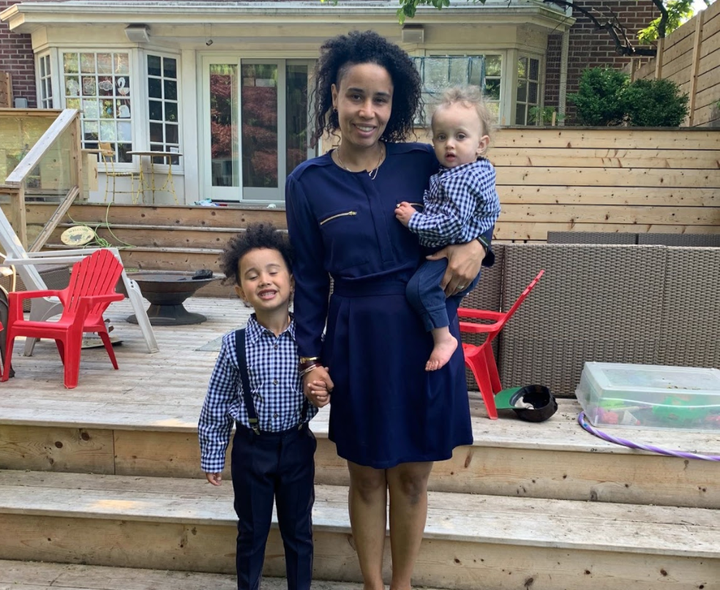
Megan: [With IVF], you can use just one vial of sperm and potentially get many embryos. Once you get the embryos, then you can freeze them and then those are your chances for IVF.
Katie: So the actual IVF treatment for our second child was paid for. Now, IVF comes with significantly higher medication costs, because for the first trimester, you have to artificially support the hormones, which means you’re on estrogen and progesterone and all kinds of medications for three-and-a-half to four months.
Megan: All those medications cost a ton of money. Plus you have to get needles every day. It’s very emotionally exhausting.
Katie: I think ballpark figure, medication for the full three or four months could be $5,000 to $10,000, depending on how much you need.
When you do IVF, they give you hormones to produce as many eggs as your body can produce. Instead of maturing one egg like you do on a regular period, you produce lots and lots of eggs. And at the time of ovulation, which is chemically controlled with the medication, the doctor goes in with a large needle through your vagina.
Megan: It’s horrible.
Katie: (Laughing) We have differing opinions on it, but they go into your vagina with a large needle and suck out all of the mature eggs.
Megan: It’s the worst thing in the world.
Katie: I disagree with that, but to each their own.
Megan: To each their own with a needle in your vagina.
Katie: No, it is invasive. You’re in stirrups, almost completely naked, with at least four or five medical professionals in the room and an entire laboratory of people behind this open window.
You have the option of just putting the eggs in a petri dish with sperm and hoping the sperm can permeate the egg and fertilize it. I think we paid an extra thousand dollars, and they would inject a single sperm into every egg to increase the number of healthy fertilized eggs you end up with.
I got pregnant with Poppy, our second, on our first try.
Katie: Our first, Duke, was Megan’s egg and the sperm donor. Our second, Poppy, I carried, and she was my egg and the same donor. And then we switched it up and with our third I carried, but it was Megan’s egg and the same sperm donor.
Megan: I think it was always the plan, that Katie would use her egg and the sperm donor. And then with the third — I don’t want to be pregnant ever again, so we knew that she would carry.
Pregnancy was magical for so many reasons; creating human life is indescribable. But I did not enjoy my pregnancy or delivery at all. I was sick almost the whole time, had a long labour that ended with a traumatic C-section, and had postpartum depression. It’s important that women understand that it’s OK not to enjoy pregnancy.
Katie: I loved being pregnant. I most loved the feeling of never being alone, always having someone with me. I love the pregnant belly, and the excitement, anticipation and wonder. For all the worst parts of being pregnant, I think I would always be willing to do it again.
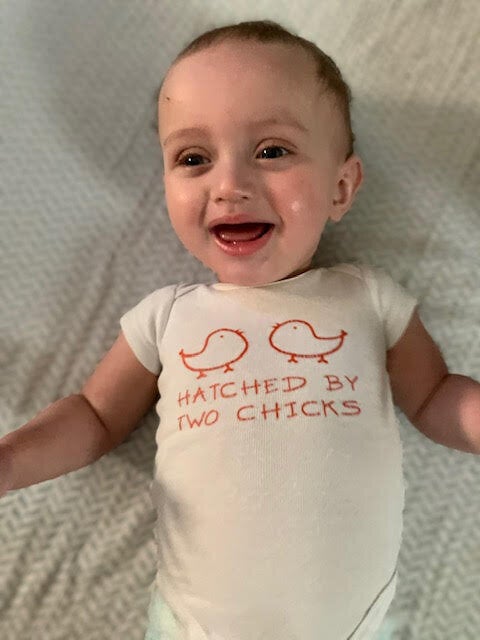
Megan: I’m so grateful that Katie had the positive experiences she did.
Katie: When we got pregnant with our third, we thought that we could qualify for another funded round of IVF, because a woman can choose to use her funded round with the use of a surrogate. Originally we thought that I would qualify as Megan’s surrogate, but we found out part way through that I don’t.
I think it was kind of a nice way for us to both be involved, to be closely connected. Dermott has lived in both of our bodies, which is kind of neat.
Katie: Oh, they know it.
Megan: In developmentally appropriate ways, they know whose body each kid was in and all about how they came out. We’re very open and candid with the kids. We want them to be proud of where they came from. We want them to have no shame, to be able to speak about it with confidence and curiosity when the time comes. There’s no secrets.
Katie: They know that mommies had to use a doctor to help because we only have eggs and we needed sperm.
Duke was delivered by C-section, and he knows that he came out of Mommy’s tummy. Poppy knows that she came from Mama’s vagina. Duke knows that he didn’t want to come out — he was a 36-hour labour, so he knows he was cosy and he didn’t want to come out. Poppy knows that she was excited to get in the world and she came out really fast. Dermott has no understanding yet, but the older two know that Dermott came from Mommy’s tummy and then was born from Mama’s tummy, that he spent time in both.
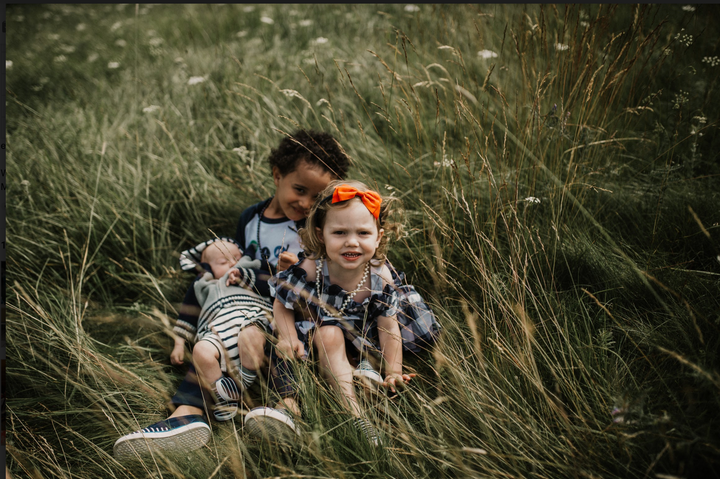
To Megan’s point, we want them to be proud of their story. But I think it’s just a reminder that we are different, and we have to really, really battle our own — would it be our own insecurities?
Megan: Internalized homophobia?
Katie: Internalized homophobia, or shame, or something. Our kids all look different, and we’ve had situations where even when we’re out as a family, it’s assumed that Megan is my nanny —
Megan: In my own neighbourhood.
Katie: It’s shocking what people feel comfortable asking. I could be on the subway, and people are asking me if I adopted or, ‘Where did he come from?’ Or ‘Are they related?’ The assumption is they’re not related, but Duke is somehow just a friend I’m bringing along.
So you find yourself having to discuss your sexuality with strangers on the subway, and it’s in front of the kids, so you don’t want to brush it off. We don’t want to teach our kids that there’s something wrong with the way that their family is designed. A lot of people assume that children don’t understand, but they are tiny but smart, and they put things together.
It’s dramatically affected the way in which Meghan and I force ourselves to live in the world. It can be uncomfortable. You want them to experience that discomfort and to know it’s OK to correct people, even if it makes the other person uncomfortable, because there’s nothing wrong with how our family is built. But you’re constantly weighing it with: Is this a safe situation? And are there allies around me that would protect me if something happened?
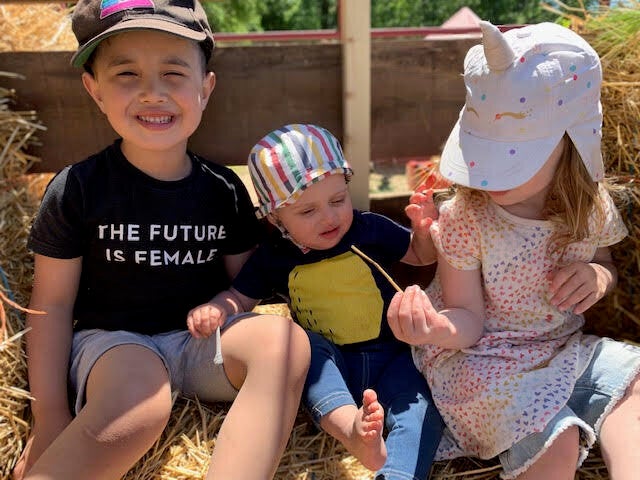
Megan: We’re talking about intersectionality, too — how race plays into it. And our sexual orientation is always at the forefront of our experiences.
Katie: Our lives are incredibly normal, but also our kids are exposed to a lot of different identities. In a lot of ways, they’re in this little bubble. But they’ll go into the world, and we’re holding our breath for the time that someone, at some point, will say something derogatory about their family or about their skin colour. As parents, those are the things that we worry about. But hopefully, the fact that they have had this time in a world where it just is will allow them to build some resilience.
As much as we talk about having to check our safety, there’s also a lot of really beautiful interactions with the world, where you just have to make the clarifying statement and people move on and it’s totally fine.
Like, Megan and I took the kids to a strawberry farm last week. We were walking through a field of strawberries, and this teenage girl came up to me, and she goes, ‘Are you two a couple? Are those your kids?’ And I was like, Yeah, she’s my wife. We’ve been married for about seven years. Those are our kids.’ And she said, ‘I hope I can have what you have one day.’ This teenage girl, witnessing our family just doing this super normal thing, it impacted her idea of what her future could look like.
Also on HuffPost: